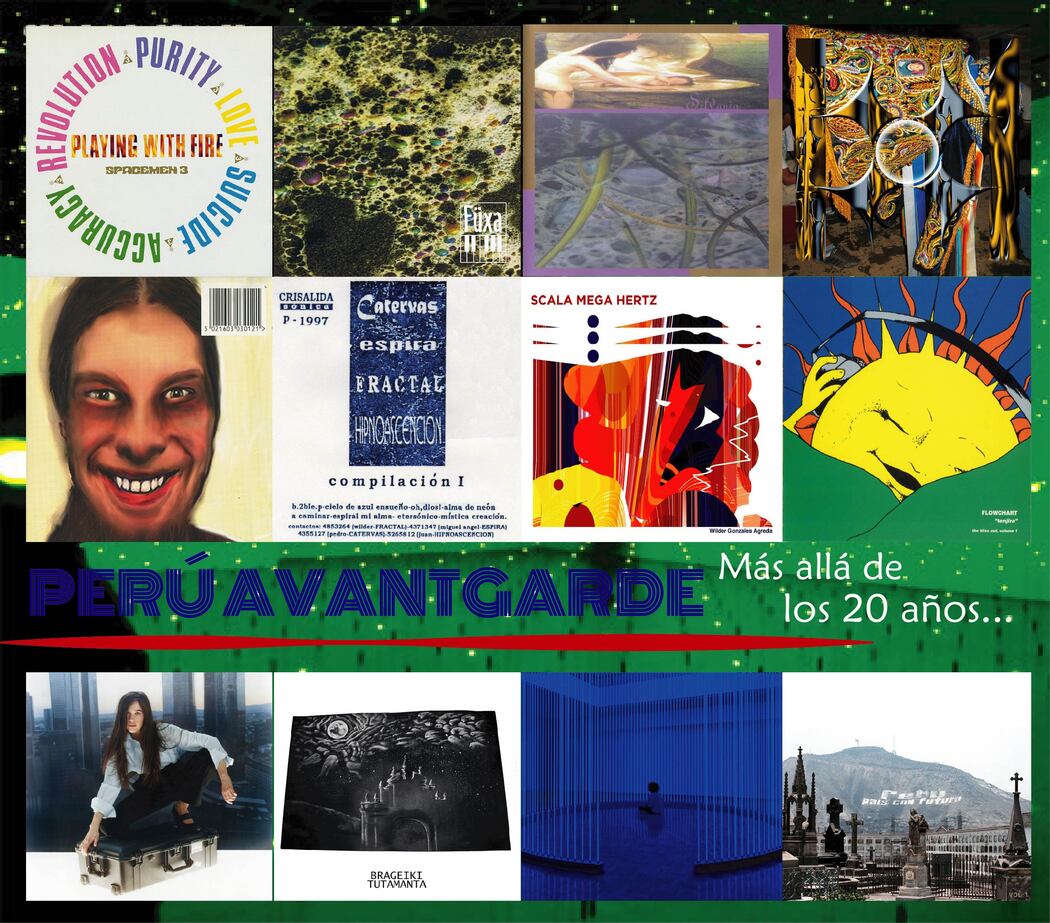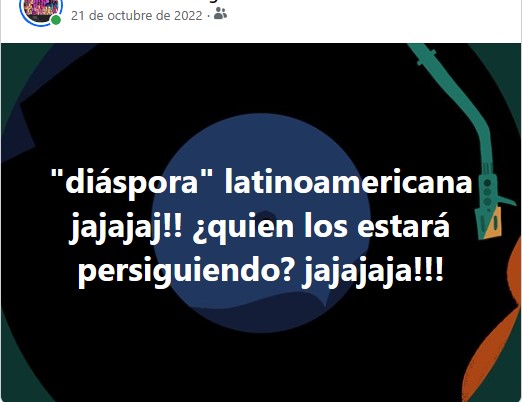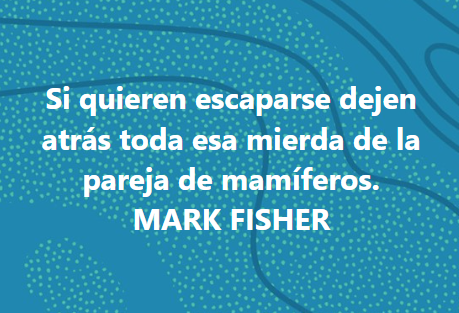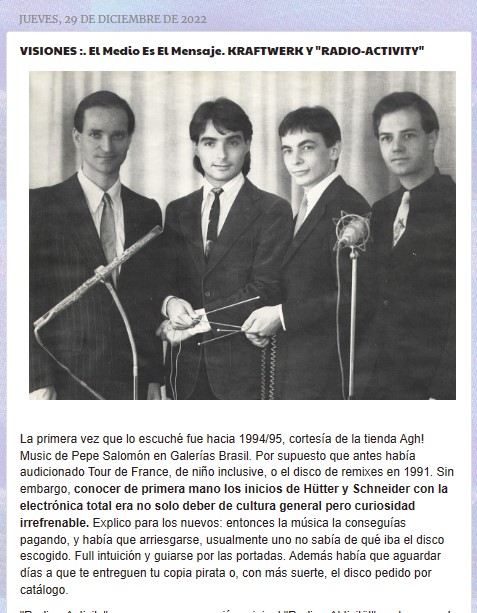Richard Devine es un músico y diseñador de sonido con base en Atlanta que pertenece a la generación IDM norteamericana de los 90. Su música profusa en capas de ritmos complejos, psicodelia ultrasónica y cerebral ha sido publicada en sellos como Warp, Schematic y Detroit Underground. A la par de su discografía Devine explora sus neuronas montando patches y módulos de fxs para Korg, Native Instruments, Clavia, et al. y armando sonidos para empresas como Google, Apple o Nike. Su futurismo sonoro expresa la conjunción entre tecnología, la manera lúdica y mucha, mucha investigación. Un placer tenerlo en da blog: para todos y para nadie.
¿Cómo y cuándo nació tu interés por la música electrónica y el IDM?
Comenzó en 1993, cuando descubrí el trabajo de Richard D. James (Aphex Twin). Compré el EP Mindstream Remixes que tenía un remix de AFX, su sonido futurista me impresionó por completo, y quise buscar más de este tipo de música. Comencé a comprar más discos de su catálogo y eventualmente descubrí Rephlex Records / Warp, etc. Estaba escuchando mucha electrónica antes de esto, y había estado yendo a muchos raves de la primera época a principios de los años noventa, pero no fue hasta que escuché su música que supe que quería crear música en este estilo y enfoque similar pero con mi propio toque personal.
La mayoría de tu trabajo navega en los campos del braindance y el intelligent tekno, has publicado en sellos como Schematic, Detroit Underground y Warp. En 1995 lanzaste "Sculpt" LP, mucho más orientado al rave y la marea psicotrópica de la época que al propio IDM. ¿Qué nos puedes contar sobre esos días y sobre ese álbum en particular? ¿Qué recuerdos a distancia de los 90 electrónicos experimentales?
Sí, descubrí muchos del primer techno de Detroit durante este período con música como el trabajo de Jeff Mills, Rob Hood, Mike Banks, Planet-E, Underground Riesistance y Drexciya. Estos artistas electrónicos pioneros me influyeron mucho y luego descubrí el trabajo de Basic Channel / Maurizio, etc. Este primer disco, Sculpt, abreviación para "esculturas", estaba destinado a representar mi primera colección de piezas minimalistas inspiradas en el techno. Fue un álbum 3 x LP (triple álbum). También hice otra colección de canciones en 1994 que luego se lanzó en Drop Bass Network. Ese disco se llamaba: Polymorphic E.P. Como mencioné iba a muchos raves de principios de los 90. Escuchando mucho techno y música ácida de la primera época. Todavía me encanta esta era, había tantas cosas nuevas sucediendo la escena techno del medio oeste. Recuerdo la primera vez que escuché a Richie Hawtin tocar como Plastikman. La escena durante ese tiempo floreció con nueva música innovadora. Estaba en la escuela secundaria en ese momento, a los 15 o 16 años, así que estaba absorbiendo todo lo que podía.
¿Cuál es tu opinión sobre los nuevos sintetizadores populares fabricados por Behringer o el Volca Korg? Ekoplekz de Inglaterra usa Volca Keys, ¿te atreverías a grabar con ellos?
Tengo todas las cajas Volca de Korg, especialmente me encantan el Volca FM y el Drum. No tengo problemas para hacer música con estos instrumentos. Personalmente no me importa si es popular o no. Solo estoy interesado en los sonidos que puede producir. Usaré un juguete para niños barato de $ 1 o un compresor estéreo multibanda de 7K (7 mil dólares), realmente no me importa. Estoy más interesado en el resultado final.
Cuéntanos sobre tu trabajo para Google, Microsoft o Nike.
Trabajo principalmente como diseñador de sonido de interacción con el usuario. Básicamente, se trata de la creación de todos los sonidos basados en la interfaz de usuario, ya sea para una aplicación, sistema operativo, juego de realidad virtual u otro entorno interactivo. También he trabajado casi 20 años haciendo anuncios de televisión para empresas de publicidad. A partir de ahí comencé a trabajar en videojuegos y diseño de sonido de Realidad Virtual con Ambisonics.
¿Cuál es tu sonido favorito?
El sonido de mi patio trasero por la noche durante los meses de verano con las cigarras y las langostas. Hay miles de ellos que viven en nuestra área. Me encanta cómo puedes escuchar a miles de estos insectos llamándose en los árboles.
¿Cómo has soportado estos días de cuarentena y pandemia? ¿Alguna idea sobre Bill Gates, Donald Trump y el covid-19?
He estado comenzando codificación en vivo usando Tidal Cycles para secuenciar mis modulares y sintetizadores en este momento. Así que he estado muy metido en el código trabajando en hacer música nueva. He visto las noticias todos los días, con Bill Gates y Donald Trump. El estado actual de las cosas en nuestro país es una locura, estamos en completo confinamiento ahora mismo. Así que hemos estado jugando en nuestro patio, criando dos bebés prang mantis y una tortuga de agua con mis dos hijos. Acabamos de regresar a la naturaleza, saliendo de excursión a los parques nacionales y montañas tratando de alejarnos de todos.
¿AFX o Ae?
Ae, me encanta lo que hacen Rob y Sean, además de que fueron las primeras personas en interesarse por mi trabajo a finales de los 90 y realmente me ayudaron con mi primer álbum en Warp Records. Buenos chicos
Si tuvieras que pasar un año encerrado, ¿qué sintetizador elegirías?
Ese tendría que ser el Nord G2 modular o el Waldorf Quantum.
¿A dónde crees que va el futuro de la música experimental?
Estoy realmente fascinado con el movimiento actual del algorave y estos nuevos artistas que crean música con código en vivo y estos sistemas creados en el entorno de código Haskell. También estoy interesado e investigando el aprendizaje automático y los sistemas basados en IA generativa en este momento para ser la base de mi próximo álbum.
||||||||||||||
RICHARD DEVINE INTERVIÚ :. Algoraves, IDM and Covid-19
Richard Devine is an Atlanta-based musician and sound designer who belongs to the American IDM generation of the 90s. His music profused in layers of complex rhythms, ultrasonic and brainy psychedelia has been released on labels such as Warp, Schematic and Detroit Underground. Along with his discography Devine explores his neurons mounting patches and fx modules for Korg, Native Instruments, Clavia, et al. and making sounds for companies like Google, Apple or Nike. His sonic futurism expresses the conjunction between technology, the playful way and much, much research. A pleasure to have him in da blog: for everyone and for noone.
How and when was your interest in electronic music and IDM born?
It started back in 1993, when I discovered the work of Richard D. James (Aphex Twin). I bought the Mindstream Remixes EP which had a remix by AFX, I was completely blown away by his futuristic sound, and I wanted to seek more of this type of music. I began buying more records from his catalog and eventually discovered Rephlex Records/Warp etc. I was listening to lots of electronic before this, and had been going to a lot of early raves in the early ninties but it wasn’t until I heard his music that I knew that I wanted to create music in this similar style and approch but with my own personal touch.
The majority of your work navigates on the braindance and intelligent tekno fields and you have published on labels like Schematic, Detroit Underground and Warp. In 1995 you released “Sculpt” LP, much more oriented to the rave and psychotropic tide of the epoch than to IDM itself. What can you tell us about those days and about that particular album? What memories at a distance from the experimental electronic 90s?
Yes I discovered a lot of the early detroit techno during this period with music like the work of Jeff Mills, Rob Hood, Mike Banks, Planet-E, Underground Riesistance, and Drexciya. I was heavely influced by these early electronic artists and then later discovered the work of Basic Channel/Maurizio etc. This first record Sculpt short for “sculptures” was meant to represent my first collection of minimal techno inspired pieces. It was a 3 XLP album. I also did another collection of tracks in 1994 which was later released on Drop Bass Network. That record was called :Polymorphic E.P. Like I mentioned before I was going to a lot of early 90’s raves. Listening to lots of techno, and early acid music. I still love this era, there was so much new stuff happening in the midwest techno scene. I remember the first time I heard Richie Hawtin play as Plastikman. The scene during that time was flourishing with new innovative music. I was just in high school at the time, at the of 15 or 16 so I was absorbing everything I could.
What is your opinion of the new popular synths manufactured by Behringer or the Volca Korg? Ekoplekz from England uses Volca Keys, would you dare to make a record with them?
I have all of the Volca boxes by Korg, I espeically love the Volca FM, and the Drum. I have no issues making music with these instruments. I don’t personally care if its popular or not. I am just interested in what sounds it can produce. I will use a $1 cheap childrends toy or a 7K multiband stereo compressor it doesn’t really matter to me. I am just most interested in the final output.
Tell us about your for Google or Nike.
I work mainly as a user interaction sound designer. That is basically the creation of all the UI based sounds, for either a application, system OS, VR game, or other interacive enviornment. I have also worked almost 20 years doing TV spots for advertising companies. From there I started working on video games and Virtual Reality sound design with Ambisonics.
What is your favorite sound?
The sound of my back yard at night during the summer months with the Cicadas and Locust. There are thousands of them that live in our area. I love how you can hear thousands of these insects calling to each other in the trees.
How have you beared with these days of quarantine and pandemic? Any thoughts on Bill Gates, Donald Trump, and covid-19?
I have been taking up live coding using Tidal Cycles to sequence my modular and synths at the moment. So been deep in code working on making new music. I have seen the news everyday, with Bill Gates, and Donald Trump. The current state of affairs in our country is crazy, we are in complete lock down right now. So we have been playing in our yard, raising two baby prang mantis’s and a water turtle with my two kids. We have been just going back into nature, by going out on hikes to the national parks and mountains trying to get away from everyone.
AFX or Ae?
Ae, love what Rob and Sean do, plus they were the first people to take interest in my work back in the late 90’s and really help me my first album on Warp records. Great guys.
If you had to spend a year in lockdown, which synth would you choose?
That would have to be either the Nord G2 modular or Waldorf Qauntum.
Where do you think the future of experimental music is going?
I am really facinated wtih the current algorave movement and these new artist creating music with live code and these systems created in the Haskell code environment. I am also interested and researching Machine Learning, and AI generative based systems at the moment to be the ground work for my next album.














